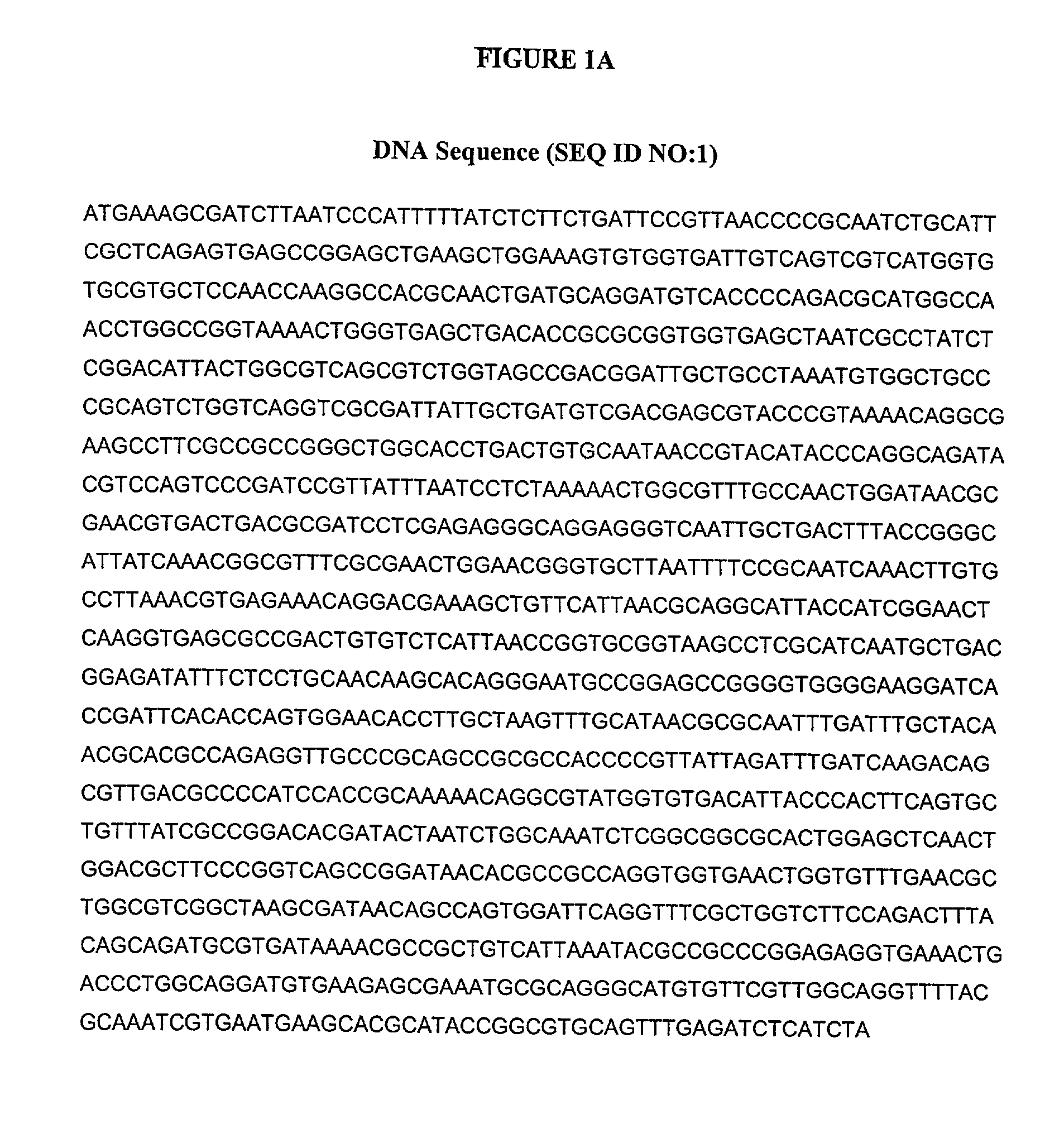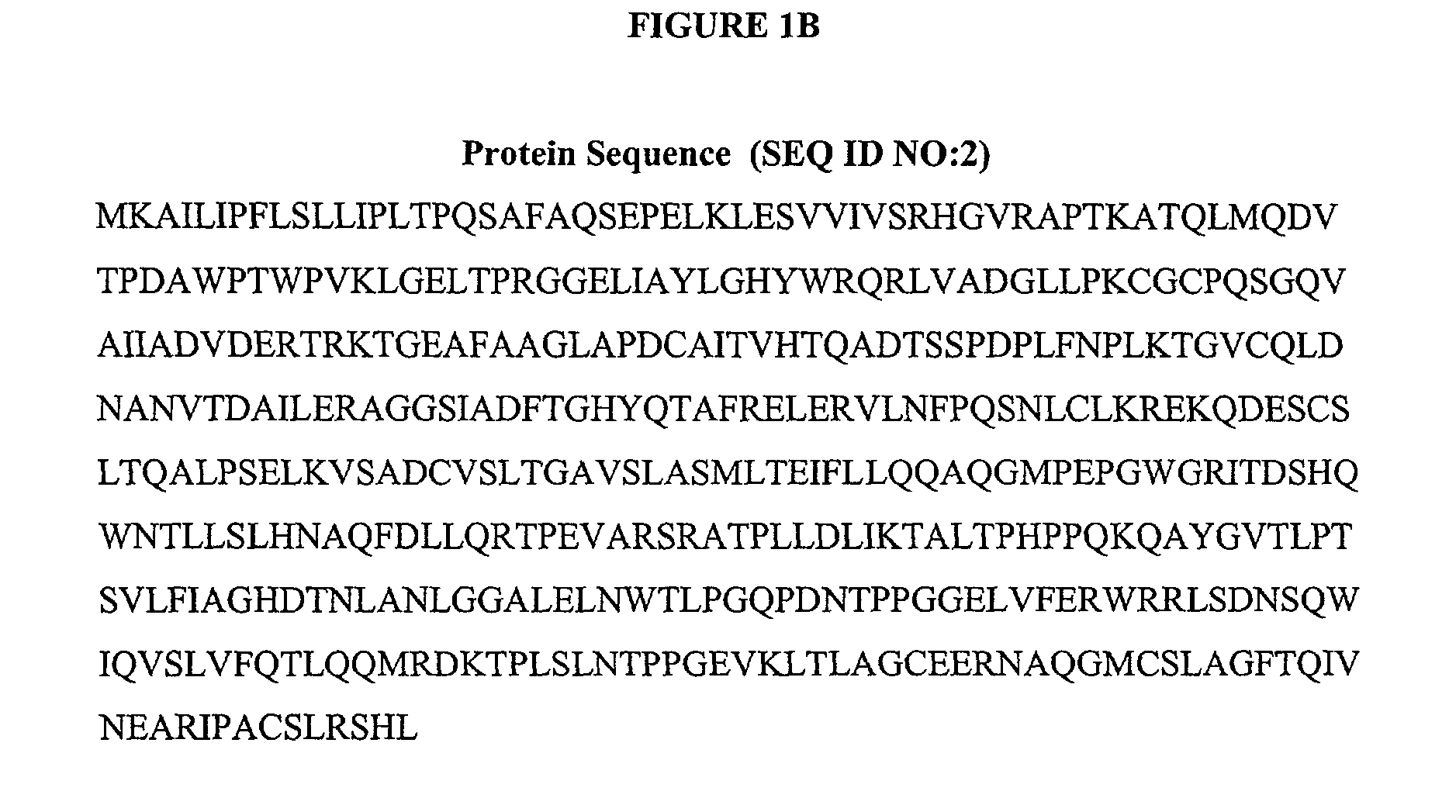Phytases, nucleic acids encoding them and methods for making and using them
a technology of phytase and nucleic acids, applied in the field of newly made polynucleotides, polypeptides, to achieve the effect of increasing the thermotolerance or thermostability and increasing the resistance of a phytase polypeptid
- Summary
- Abstract
- Description
- Claims
- Application Information
AI Technical Summary
Benefits of technology
Problems solved by technology
Method used
Image
Examples
example 1
[0653]The wild type phytase appA gene from E. coli (strain K12) (SEQ ID NO:3) (FIG. 13), which encodes a wild type phytase (SEQ ID NO:4) (FIG. 14), was used to prepare a GSSM-modified polynucleotide. The modified polynucleotide having a sequence as set forth in SEQ ID NO:1 (FIG. 1A) encodes a non-glycosylated phytase (SEQ ID NO:2) (FIG. 1B). Specifically GSSM was employed to find single point mutations that enhanced the thermotolerance of the E. coli K12 appA. Eight variant polynucleotides that contained point mutations that enhanced thermotolerance were identified. These eight mutations were combined into a single protein as shown in FIGS. 8A and 8B.
[0654]The wild type and mutagenized polynucleotides were expressed in E. coli and purified to homogeneity. In the thermal tolerance assay, 100 μL of 0.01 mg / mL of protein in 100 mM MOPS / pH 7.0 was heated to 37° C., 50° C., 60° C., 70° C., 80° C. or 90° C. in an RJ research thermocycler. Upon completion of the 5 minutes at the incubation...
example 2
Stability of Phytase Enzyme in Simulated Digestibility Conditions
[0655]The present example shows the effect of a simulated gastric intestinal fluid on digestion of glycosylated and non-glycosylated phytase of SEQ ID NO:2. The percent residual activities (based on initial rates) of the in vitro digested E. coli K12 and the non-glycosylated phytase of SEQ ID NO:2 were plotted verses time. A standard concentration of simulated gastric intestinal fluid (SGIF) containing 2 mg / ml NaCl, 6 M HCl and 3.2 mg / mL pepsin was prepared as described. The pH of the solution was about 1.4 and was not adjusted. The in vitro digestibility assay was performed by adding 1:4 (vol:vol) of phytase to digestion solution and immediately incubating at 37° C. to initiate the digestion reaction. Aliquots of the digestion reaction mixture were removed at various time intervals and assayed for residual phytase activity using the TNO assay. Each of the assays was performed at least twice. An exponential curve with ...
example 3
Glycosylation Stabilizes Phytase to Pepsin Digestion
[0656]Experiments were conducted to evaluate the effect of glycosylation on the half life of phytase enzyme activity exposed to pepsin, used as a simulated intestinal gastric fluid since pepsin is one of the major components of intestinal gastric fluid. Results of studies examining the half life of phytase exposed to pepsin are presented in FIG. 5. These results indicated that glycosylated forms of phytase have longer half-life than un-glycosylated forms of the enzyme.
[0657]Computer analysis provides a means of predicting putative amino acid residues that are post-translationally modified by glycosylation. The prediction of glycosylated sites of phytase was done using the Post-translational Modification Prediction program on the world wide web at address expasy.ch. The glycosylated peptide identification was mapped by PeptideMass program in the same website. Predicted glycosylation sites for phytase are presented in FIG. 6.
[0658]St...
PUM
| Property | Measurement | Unit |
|---|---|---|
| temperature | aaaaa | aaaaa |
| temperature | aaaaa | aaaaa |
| temperature | aaaaa | aaaaa |
Abstract
Description
Claims
Application Information
 Login to View More
Login to View More - R&D
- Intellectual Property
- Life Sciences
- Materials
- Tech Scout
- Unparalleled Data Quality
- Higher Quality Content
- 60% Fewer Hallucinations
Browse by: Latest US Patents, China's latest patents, Technical Efficacy Thesaurus, Application Domain, Technology Topic, Popular Technical Reports.
© 2025 PatSnap. All rights reserved.Legal|Privacy policy|Modern Slavery Act Transparency Statement|Sitemap|About US| Contact US: help@patsnap.com



